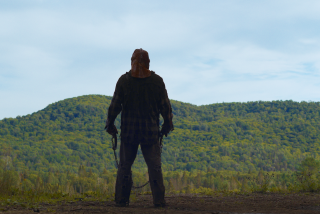Updated Shooter Aims to Stay True to Classic
One of the granddaddy titles of games is “Wolfenstein 3D,” a first-person shooter that spawned “Doom” and “Quake.”
It wasn’t exactly three-dimensional graphics as most gamers have come to think of them. The walls met at right angles and the environments looked flat. Nevertheless, the game gripped a generation of trigger-happy geeks.
Now comes “Return to Castle Wolfenstein,” the great-grandson of the original, to milk the nostalgia factor. Released nearly 10 years later, “Return to Castle Wolfenstein” represents a coda to the evolution of the shooter genre thus far. The graphics are far more realistic, the enemies react more intelligently and the animation is more lifelike, thanks to the use of motion-capture techniques that match character gestures to the movements of live actors.
Three studios collaborated to make the game, including Id Software, the creators of “Wolfenstein 3D” and the executive producer of “Return to Castle Wolfenstein.” Gray Matter Interactive Studios built the single-player mode, and Nerve Software developed the multi-player campaigns. Like the original, the new title focuses on killing as many Nazis as possible.
Drew Markham, creative director of Gray Matter in Los Angeles who worked on “Redneck Rampage” and “Kingpin,” discussed the pressure of inheriting the “Wolfenstein” mantle and what his team did to improve upon the classic.
Question: How did you come up with the idea of a follow-up to “Wolfenstein 3D”?
Answer: We were working with Id on “The Reckoning,” and we kept seeing the “Wolf” poster on their wall. It was such a seminal title that we thought somebody needed to do something on this again. So we asked them if they were ever going to do a sequel. They said they hadn’t really thought about it. Every time we went down to see them we bugged them about it. So they finally let us.
Q: With a game like this, you’re dealing with a host of fan expectations. How did you work with that?
A: Anytime you have something like this, if you let 100 people make the game, you’d have 100 different games. For a seminal title like this, everyone was going to have their own idea of what the game should be. So it boiled down to working with Id and doing what they thought was in keeping with the spirit of the original games.
When the first-person shooter genre came out, it was basically point the gun, pull the trigger, move, pick up health, pick up ammo. Over the years, the genre hybridized into other genres. Third-person shooters, action-adventure, puzzle-shooters, you name it. So there was this big palette of games to choose from.
We wanted to keep the flavor of the original, but fold in as much of the cool stuff as we could to make it contemporary. Even though it’s a nostalgic game, it still has to survive in a contemporary market.
Q: What parts of the old version did you keep?
A: The essence of the old game was always wanting to know what was around the next corner. Secrets also played a big part--secret walls that move revealing secret areas. You feel so good when you find those. That was a huge part of [“Wolfenstein 3D”].
The other thing was that the first game was so compelling and groundbreaking that it led you to believe things were going on that really weren’t. It made your mind more fertile. You have this experience that’s completely real to you. It mixed with your head and put you in a completely different space. So we tried to recapture that, too.
Q: How did you approach the use of violence in this game?
A: We tried to keep true to the original. If you look at the original game, it’s not super gory. It’s more moody, movie violence. We wanted to keep it to that, like a movie about World War II. Plus, we added supernatural elements. You’ve got zombies and spooky paranormal activities. One of the elements of the original was an over-the-top comic book feel.
Q: What are the hallmarks of a first-rate game in this genre?
A: Pacing. That’s one of the things that’s missing in a number of games. You can’t have the volume at 10 all the time. The notes you don’t play are just as important as the ones you do. If you want the player to be hyper-aware, you can use silence. I like the roller-coaster-ride feel of having lots of contrast. I think that’s what makes a great movie and a great game.
Of course, visuals need to be top-notch. And sound is key. If you don’t get the sound right, it can kill a game. There was a game that came out three or four years ago that was stunning visually, but the gun sounded like it was shooting Jell-O. You need that sound element to be on target--the gun has to sound like a gun. We got to play around with an interactive music system. It was amazing watching people play the game with and without the music and watching how their bodies tense up so much more with the music on.
Q: What about the artificial intelligence engine?
A: AI is critical. That’s an area that’s nascent right now. In the early days, it was easy because you had the player and you had enemies. And the enemies were all hostile. That’s an easy behavior model to develop. There’s no gray scale; it was pure hostility. When you get into ambiguity, that’s when it becomes a lot more difficult.
Q: If processing power were no object, what kind of AI would you build?
A: The AI is just a matrix of decision making. Right now, it’s difficult when you have 15 enemies on the screen, all scrolling through all the parameters in real time. All those decisions take cycles off the [central processing unit]. We have to do tricks to economize on the CPU. We have to cheat. So the enemies have to think in little blocks and cycles, taking turns sharing the cycles.
As processor power becomes greater, you can have characters with steady thought states. He’s constantly making decisions based on his personality, his environment.
We’re doing that now, but we’re faking a lot of it. In our game, if I get this monster gun, the guards will run away from me if they see the gun. They know they’re outgunned.
We’re just scratching the surface. Someday, these guys will have real eyeballs and they can make decisions based on what they see, not whether certain nodes have been triggered, which is one of the ways we fake it now.
*
Alex Pham covers the video game industry. She can be reached at alex.pham @latimes.com.
More to Read
The biggest entertainment stories
Get our big stories about Hollywood, film, television, music, arts, culture and more right in your inbox as soon as they publish.
You may occasionally receive promotional content from the Los Angeles Times.










